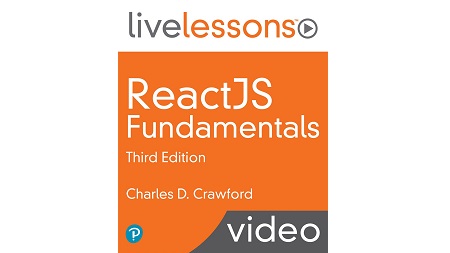
English | MP4 | AVC 1280×720 | AAC 44KHz 2ch | 6h 39m | 3.81 GB
Get started with React.js for front-end web development
React.js Fundamentals LiveLessons, Third Edition, covers vanilla React and presents a refresher on some advanced JavaScript topics and essential ES6 features. You first learn how to create a modern React toolchain. Next, the training covers the advanced JavaScript concepts that regularly pop up in React and the modern ES6 features you’ll need to write more idiomatic React code. Next, the training covers a conceptual understanding of React and takes an in-depth look at how React’s virtual DOM works. Starting in Lesson 6, you dive into writing React code using the original create class syntax and begin to look at the JSX. Next, you see how to rewrite your earlier code using modern es6 features. From there, you learn the remaining vanilla React topics, such as component lifecycle and state management. The training wraps up with a discussion of how you can tweak performance in React apps, use styling, and create functional components.
Learn How To
- Utilize the React toolchain
- Understand the advanced JavaScript features used with React
- Use ES6 features with React
- Understand basic React concepts
- Utilize React’s virtual DOM
- Code a React app with traditional and ES6
- Optimize React performance
- Utilize libraries to make React a complete front-end solution
- Use React router
- Use Flux
- Use Redux
- Test React applications
- Use React functional components
Lesson 1: Creating Your React ToolChain
The first lesson covers Webpack and Babel and shows you how to use them to create your React toolchain. You also learn how to leverage CreateReactApp to bootstrap your development.
Lesson 2: Understanding Advanced JavaScript Required for ReactJS
Lesson 2 covers advanced JavaScript topics that regularly come up in React such as context binding and functional programming.
Lesson 3: Utilizing ES6 in Your React Applications
Lesson 3 teaches you some modern ECMAScript 6 features in order to help you write more idiomatic code. The lesson also explores Async await.
Lesson 4: Understanding Basic React Concepts
Lesson 4 covers the basic concepts behind the React framework including component-based design and use of one-way data flow and rendering.
Lesson 5: Understanding the Virtual DOM
Lesson 5 is all about how React’s virtual DOM. The lesson takes an in-depth look at how it works, contrasting it with the actual DOM and exploring the diffing algorithm.
Lesson 6: Coding Your First React App with Traditional React
In Lesson 6 you start writing some react code using the original createCass syntax and begin to look at JSX and setting initial app state.
Lesson 7: React Fundamentals with New ES6 Syntax
In Lesson 7 you learn how to rewrite your earlier code using modern ES6 features. It also covers more React basics such as component lifecycle and state management.
Lesson 8: React Performance
Lesson 8 covers the topic of how to improve React app performance. It starts with improving child rendering performance by setting keys. It then moves on to implementing performance optimization by setting keys.
Lesson 9: Styling with React
Lesson 9 explores a number of different ways that React applications can be styled. This includes inline styles, external style sheets, manually configuring CSS modules, and implementing CSS modules with styled-jsx.
Lesson 10: React Functional Components
Lesson 10 explores another way to write React applications–functional components with hooks and effects.
Table of Contents
1 ReactJS Fundamentals – Introduction
2 Learning objectives
3 Understand the requirements of your toolchain
4 Use NPM to manage your application’s dependencies and run tasks
5 Compile ES6 to ES5 with Babel
6 Bundle applications with Webpack
7 Understand how Babel and Webpack work together and create a basic build process
8 Create a development optimized build process
9 Create a production optimized build process
10 Use create-react-app
11 Learning objectives
12 Use functional programming in JavaScript
13 Understand execution context and the this keyword!
14 Control execution context with bind call apply
15 Learning objectives
16 Understand ES6 template strings
17 Understand ES6 default arguments
18 Understand ES6 rest and spread
19 Understand ES6 arrow functions
20 Understand ES6 destructuring (bug fix)
21 Understand ES6 modules
22 Understand ES6 classes
23 Understand ES6 promises, Part 1
24 Understand ES6 promises, Part 2
25 Understand ES6 promises, Part 3
26 Understand ES6 fetch
27 Understand ES6 generators
28 Combine generators and Promises
29 Understand Async await
30 Learning objectives
31 Utilize component-based design
32 Use one-way data flow and rendering
33 Learning objectives
34 Understand the virtual DOM versus the actual DOM
35 Understand the diffing algorithm
36 Learning objectives
37 Use createClass and render
38 Understand JSX
39 Set initial app state
40 Learning objectives
41 Create with new ES6 class syntax
42 Understand properties and state
43 Add new state to an app
44 State changes through child components
45 Use inputs with React
46 Understand functional stateless components
47 Utilize data fetching in React applications
48 Understand React component lifecycle methods
49 Utilize content of custom components
50 Understand higher order components
51 Utilize propTypes
52 Utilize ref to access child components
53 Learning objectives
54 Improve child rendering performance by setting keys
55 Implement performance optimizations with shouldComponentUpdate
56 Learning objectives
57 Use Inline styles
58 Use external style sheets
59 Manually configure CSS modules
60 Implement CSS modules with styled-jsx
61 Learning objectives
62 Create Stateless Functional Components
63 Create terser functional components with arrow functions
64 Create terser functional components with parameter destructuring
65 Create stateful function components with useState
66 Add lifecycle events to function components with useEffect
67 Create custom useEffect functions for function components
68 ReactJS Fundamentals – Summary
Resolve the captcha to access the links!